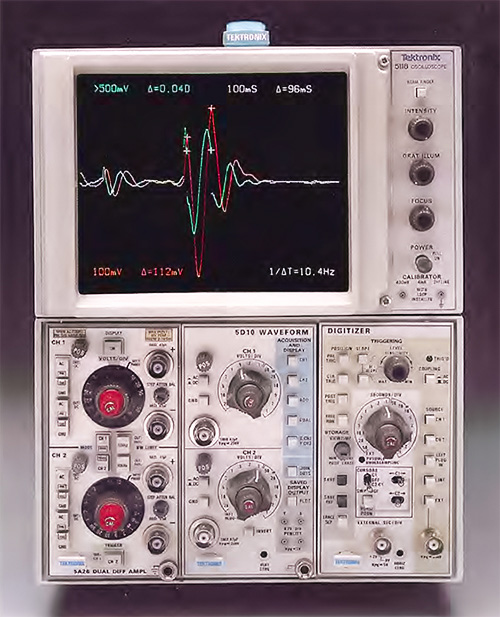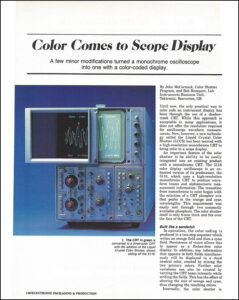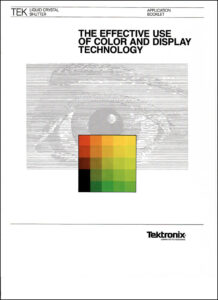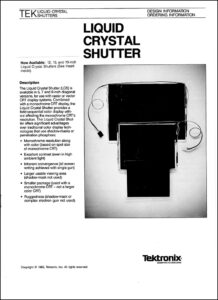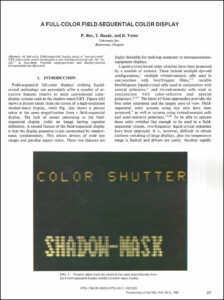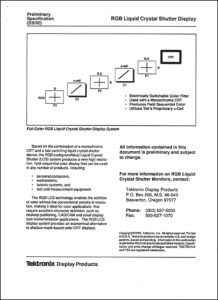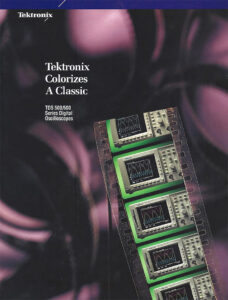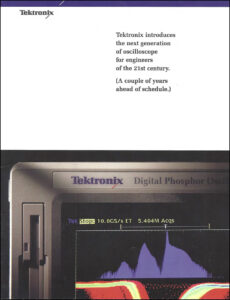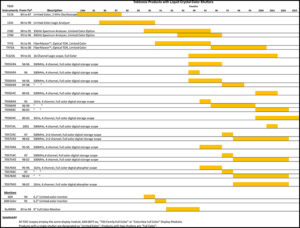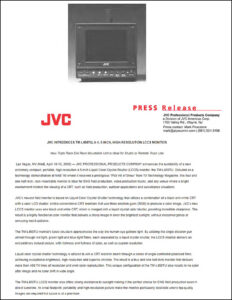In the spring of 1984, Tektronix introduced a groundbreaking new product, the 5116 oscilloscope. Unlike other oscilloscopes that offered new levels of performance, the 5116 wasn’t faster than its predecessors, or have more channels, or have unique storage features. Overall it sat in the middle performance range of Tektronix products. But it was a pioneering offering — the first of more than 50 products that would utilize a technology that had lain dormant since the early days of color television. This technology, called field-sequential color, would be reanimated at Tektronix by incorporating the new field of liquid crystals. This innovation brought color into the world of precision electronic measurement.
The desirability of color in electronic measurement displays becomes evident as soon as more than one signal is displayed. The problem seen by an electrical engineer in the 1970s when looking at four different electrical signals on an analog oscilloscope was how to distinguish which signal was related to which input. What was needed was a way to take a monochrome analog oscilloscope CRT display and somehow convert it to color. In this way, each signal could have its own color, making it much easier to see what was going on. Having each waveform a different color visually untangles the image making analysis much easier, intuitive, and clear.
In the 1970s, the liquid crystal (LCD) and organic light emitting diode (OLED) flat panel displays that are ubiquitous today were primitive or had not yet been invented. The only display technology capable of producing a multi-color display at that time was shadow-mask CRT technology used in color televisions of that time. But shadow-mask CRTs were not suitable for use in an oscilloscope because their resolution was low.
The technology that made the first color oscilloscope possible is the Liquid Crystal Color Shutter (LCCS) that was invented at the Royal Signals and Radar Establishment (RSRE) in Malvern, England in the 1970s. Tektronix had a connection to the RSRE through founder Howard Vollum who had worked on the development of radar in England during WWII. RSRE inventors Ian Shanks and Mike Clark connected with John McCormick and his display research team at Tektronix Laboratories in Beaverton to help further develop the technology. Work at Tek Labs addressed many of the shortcomings of the RSRE device and extended its capabilities greatly, transforming a crude laboratory demonstration into a product-worthy technology. This October 3, 1974 Electronics article describes the state of the technology before Tektronix took the lead in developing the color shutter into a useful display technology.
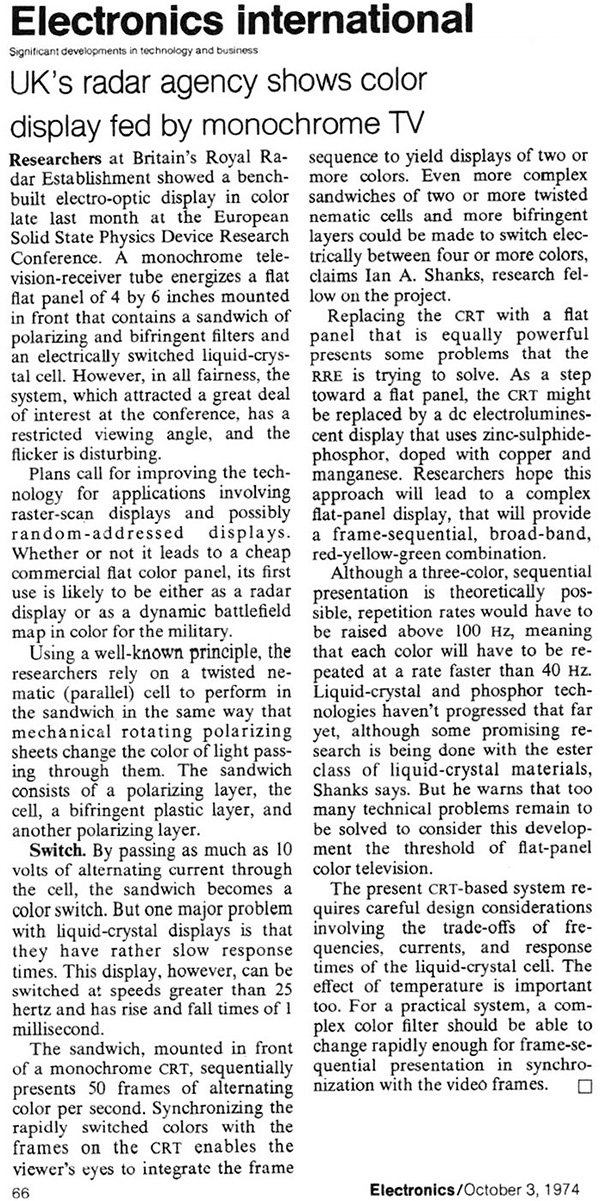
The 5116 oscilloscope was introduced with a LCCS color display just ten years after the RSRE proof of concept demonstration. Numerous technology enhancements and inventions had been made including improved color (dichroic) polarizers, specialty CRT phosphors, high frame-rate CRTs, and most importantly the invention of a new liquid crystal cell. The new liquid crystal, called the pi-cell, was invented at Tek Labs by Phil Bos and Phil Johnson who solved the temperature sensitivity and viewing-angle limitations that plagued the earlier cells used at the RSRE. Click on the image to view the 5116 brochure.
This March 1984 Electronic Packaging and Production article Color Comes to Scope Display details how these technologies come together—CRT, phosphor, polarizers, pi-cell—to transform a monochrome CRT into a color display. Click on the image to view the PDF.
This Liquid Crystal Application Booklet was written in 1984 by Jerry Murch who directed human factors research in the Applied Research Group. Click on the image to view the PDF.
The Liquid Crystal Shutter Strategic Business Unit (SBU) offered products for sale outside of Tektronix. This 1985 Ordering Information brochure is for the two-color version. A label was added to this brochure for the 12", 15", and 19" options with an insert dated 1988 describing those products on the last two pages of the brochure. Click on the image to view the PDF.
One of the constraints of early color shutter systems was that they could only display a limited color palette: two primaries such as red and green, plus a mixture of both primaries to give yellow. For the 5116, cyan and orange were chosen as primaries, whose mixture provided an intermediate yellowish color. But like the red and green primary system, the overall pallet of the 5116 display was constrained to a narrow range of colors. Finding a way to produce a full-color palette was an obvious next step, and that invention is described just a year after the introduction of 5116 in a 1985 Society for Information Display paper written by Phil Bos, Tom Buzak, and Rolf Vatne. Click on the image to view the PDF. The paper is courtesy of the Society for Information Display. © Society for Information Display.
The small number of colors produced by the limited-color displays did provide a great way to distinguish signal waveforms from one another—displaying signal traces that were sharp, high-contrast, and in a compact form-factor that was ideal for test and measurement products. That was the original motivation for the development of color shutter technology at Tek Labs. But when Tek Labs researchers extended the LCCS capability to the full-color, a new dimension for signal analysis became available.
This 1990 preliminary specification is for the full color RGB Liquid Crystal Shutter display. Click on the image to view the PDF.
New oscilloscope features like InstaView and Digital Phosphor provided the capability to acquire as many as 300,000 signals/second and then display all those waveforms in one screenshot, color-coding them by how often they occurred. For example, the traces in an “eye diagram” of many superimposed signals could be color-coded blue for infrequent traces and red or white for the most common. In this way the display could make key information jump out from the noise and clutter. It was color-enabled features like these that helped convince users that digital scopes could indeed replace their long-trusted analog scopes. Color, together with honest and accurate instrument specifications, and a reputation for high quality, helped maintain Tektronix as the market leader in oscilloscopes for many years.
Examples of colorful “eye diagrams” and other images from a Digital Phosphor Oscilloscope using a full-color LCCS can be found in the publications Tektronix Colorizes a Classic and Tektronix Introduces the Next Generation of Oscilloscopes for Engineers of the 21st Century. Click on the images to view the PDFs.
The full-color LCCS, together with the limited-color version, spawned a large number of Tektronix products that included oscilloscopes, logic analyzers, optical TDRs, computer and monitors. We have compiled a list of nearly 30 Tektronix products that utilized LCCS technology. Click on the image to view the PDF.
JVC produced a popular 4.5" diagonal monitor using a Tektronix shutter. This press release describes the TM-L450TU color display.
This Hackaday web article and video features this color display.

